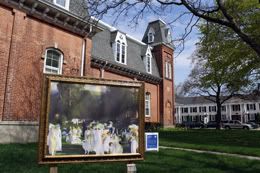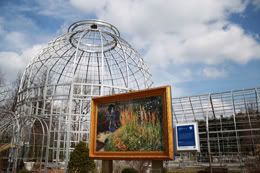|
|
Director's Letter
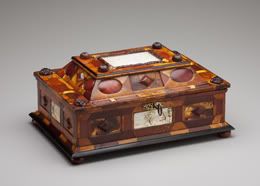
| | |
Gottfried Wolffram, Danish (?); Courtly Amber Casket, ca. 1695; amber, ivory, wood, glass, brass, velvet. Museum Purchase, Robert H. Tannahill Foundation Fund
| |
The European Fine Arts Fair (TEFAF), held every year in Maastricht in the Netherlands, celebrated its twentieth-fifth anniversary this year. What started as a presentation of about thirty-five mainly Dutch dealers of Dutch art has grown into what is widely regarded as the most impressive and powerful art fair of its kind anywhere in the world. There are now more than 300 exhibitors presenting everything from ancient Chinese tomb figures to Cindy Sherman photography, from African statuary to nineteenth-century academic paintings. To celebrate the twenty-fifth year of the fair, the organizing committee--all prestigious art dealers and serious collectors--selected twenty-five pieces that represented exceptional purchases over the years and published them in a commemorative volume. It was hugely gratifying to discover that a piece acquired three years ago by the DIA was among the works selected.
In 2009, Alan Darr, the DIA's senior curator of European art and the Walter B. Ford II curator of European sculpture and decorative arts, had identified a rare seventeenth-century amber and ivory casket as being particularly special and put a hold on it while we talked to the group of DIA patrons who had accompanied us to Maastricht about helping with the purchase. We were soon able to tell the dealer in question (with whom we had negotiated a 20 percent reduction in the asking price) that we, indeed, intended to present the piece to the museum's Collections Committee as a proposed purchase. A reduced price often means that the dealer is expecting fairly prompt payment--something, because of our review procedures, U.S. museums are rarely able to achieve. In this case, Alan and I felt very confident about the DIA acquiring the casket, but neither we, nor the dealer, expected the unusually long delay caused by international regulations on the export and import of ivory.
In the end though, the piece arrived at the DIA, was added to our collection, and can now be seen in the third floor Decorative Arts Court. If you come to look at it, you might also look at the rather different, early eighteenth-century German jewel casket just a few feet away. I hasten to add that we do not only look to Maastricht for caskets, and if you walk into the Dutch galleries behind the amber and ivory piece and look left in the first gallery, you will see a small but intense moonlit landscape by Aert van der Neer acquired at the fair. And in the late Rennaisance and baroque galleries on the second floor you can see an exquisite rock crystal and gold late sixteenth-century Italian crucifix and a rollicking early seventeenth-century Dutch painting.
As I've mentioned before, these wonderful additions to the collection are only possible through the generosity of individual donors who give, or leave as bequests, significant sums of money to be used exclusively for the purchase of art. Given the enormous challenge the DIA confronts every year to raise annual operating funds, several years ago I asked family members of the two most significant acquisition-fund bequests to consider using the income from the endowments to help us through these tough times. They--and the probate court--agreed that the giving history of their relatives indicated that they would have looked sympathetically on our situation and consented to the redirection of funds to operations for five years. So it was that we went to Maastricht this year with much less fire power than in the past.

Graham W. J. Beal
Back to top |
|

Exhibitions
Detroit Revealed
Photographs, 2000-2010
Through April 29
Albert and Peggy de Salle Gallery of Photography
 | | |
Corine Vermeulen, Dutch; William from the series Your Town Tomorrow, Detroit, 2001-2011, 2010 (printed in 2011); pigment print. Museum Purchase, Albert and Peggy de Salle Charitable Trust
| |
This is the last month to see Detroit Revealed, the exhibition that explores the nature of Detroit's community, the city's history, and its future through the lenses of eight contemporary photographers working from 2000 to 2010. The stories these pictures tell go beyond the widely circulated images of the city's empty buildings and give visibility to the vibrant, often surprising, culture of the city and its people. And the exhibition has inspired others to investigate Detroit in various ways.
Two programs, one run by the DIA and the other by the Detroit Free Press, offer opportunities for people to show off their own take on the city. "Reveal Your Detroit" is the museum's community-based project that is soliciting the public's creative response to the exhibition. More than fifty community groups have partnered with the museum to extend this experience to residents throughout the city. All area residents are invited to photograph the people, places, and things that give meaning to their lives in Detroit and post them on the DIA's Flickr page. Check them out and look for an exhibition of select submissions this summer at the main Detroit Public Library.
In "Detroit Self-Portrait," the Free Press asked readers to share their interpretations of the city in response to outsiders who seek to define the imagery of our region. The response, the paper reported, has been astounding and inspiring with pictures--both beautiful and haunting--that show empathy for and understanding of what makes metro Detroit tick. Two of the Detroit Revealed photographers, Michelle Andonian and Carlos Diaz, were asked to pick their favorites among the myriad submissions.
Over at the Hamtramck art gallery Public Pool, a third exhibition participant, Scott Hocking, curated the show A Divining Lens, choosing three emerging photographers--Lauren Semivan, Clinton Snider, and Megan Major--whose unique approaches demonstrate what photography can be.
Detroit Revealed inspired the literary arts as well as the visual. At a panel discussion last month exploring teenagers' opinions of the city, high school senior Joseph Verge, a member of the citywide InsideOut literary initiative (not to be confused with the DIA project of the same name), read from his poem "Taking Root" about living in Southwest Detroit:
Our city's hopes live there, like dandelions
yawning beneath the sun on Sunday morning
They grow on city roads and school yards,
on the surface of children's minds,
in the hearts of people who've been left behind
by everyone else.
Click here to read Joseph's entire poem (scroll down to the bottom) and other student works about the city.
For information about DFT films presented in conjunction with Detroit Revealed click here.
This exhibition has been organized by the Detroit Institute of Arts. Support has been provided by Quicken Loans and Team Detroit. Additional support has been provided by the City of Detroit. Support for the catalogue has been provided by Furthermore: a program of the J. M. Kaplan Fund. "Reveal Your Detroit" is funded by the John S. and James L. Knight Foundation
Above: Scott Hocking, American; Concord Swamp Swift, Spring, from the series The Zone, 2009 (printed in 2010); pigment print. Museum Purchase, Coville Photographic Fund
Back to top
Once Upon a Time
Prints and Drawings that Tell Stories
Through May 13
Schwartz Galleries of Prints and Drawings

| | |
Karsten Creightney, American; Burial, 2009; lithograph printed in black ink. Museum Purchase, Hal H. Smith Fund
| |
The stories told by the 180 prints and drawings in this exhibition vary from myths and legends to classic literature, drama, and nonfiction. Some images include explanatory or related text, but others appear without words. These works are often based on the artists' autobiographical experiences and rely on the strength of their visual presentation alone to successfully convey or suggest a narrative that viewers can "read."
Karsten Creightney's Burial, a set of nine lithographs, is a good example of personal storytelling. Creightney transformed his own musings about the life and death of his uncle into images that appear dreamy and rambling, like the wanderings of the mind. Viewers see a male figure who appears to roam between worlds of health and beauty and the dangers of the drug culture. The prints are hung linearly, but the artist has no specific order or sequencing that he demands or that the story requires. The negative outcome of the plot is alluded to in various prints: the inclusion of skulls in one enigmatic landscape and a cemetery with rows of old tombstones in another.The burial suggested in the title is not only a straightforward funeral but perhaps also a nuanced reference to long forgotten thoughts or the overwhelming nature of addiction.
Creightney combines lithographic techniques in clever, complex ways to create scenes that are unconventional and refreshing. He uses a scratching technique to create white lines to represent blades of grass or the calm surface of water. He draws with traditional crayons and washes to work-up major portions of the images but also introduces the photo-transfer of selected photocopied subjects to give the scenes a collagelike appearance. He left blank spaces around some elements of the compositions so they resemble paper cutouts. For most of the skies and other wide flat expanses of space, he sprayed a liquid version of the greasy lithographic medium onto the stones with either an aerosol-like device or carefully splattered those areas.
Back to top
Seventy-Fifth Annual Detroit Public Schools Exhibit
April 28 through June 3
Walter Gibbs Learning Center in the Wayne and Joan Webber Education Wing
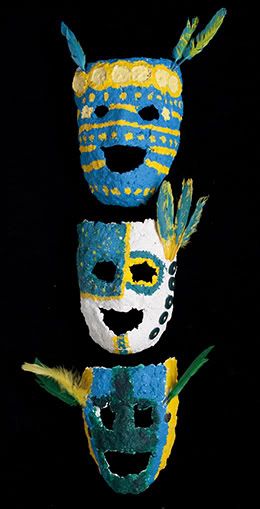 | | |
Masks, Blackwell Institute, Grade 8
| |
Hundreds of imaginative works, including paintings, prints, drawings, photography, ceramics, videos, and jewelry created by Detroit Public Schools students go on view later this month in the annual Detroit Public Schools Student Exhibition. Students in kindergarten through high school from dozens of schools participated.
This year marks the seventy-fifth anniversary of the collaboration between the DIA and the Detroit Public Schools. A reception for students and their families will be held Saturday, April 28, from 1 to 3 p.m.
The Seventy-Fifth Detroit Public Schools Student Exhibition was organized by the Detroit Institute of Arts and the Detroit Public Schools, and is made possible with support from the Charter One Foundation and the Ruth R. Cattell Education Endowment Fund. Additional support was provided by the City of Detroit.
Back to top |
|
 Detroit Film Theatre Detroit Film Theatre

| | |
Urban Roots, photo by Sylvie Shain
| |
While both Thursday, April 5, showings of Louder than Love, part of Detroit Revealed on Film, are sold out, tickets for two other films in the series are still available. Urban Roots, an examination of the urban agriculture movement, plays Thursday, April 19, and Detroit/State Theater, a kaleidoscopic look at the aspirations of Detroit's citizens and civic leaders, is set for Thursday, April 26. Both films begin at 7 p.m. in the DFT auditorium. Playing continuously through the end of Detroit Revealed is the short film plant (3D), a three-dimensional investigation of Detroit's abandoned Packard auto plant over a three-day period. It can be seen through April 29 on the second floor near the Special Exhibition Galleries: South.
For those still wanting to see Louder than Love, the Michigan Theater in Ann Arbor has a screening Monday, April 9, at 7 p.m.
On Saturday, April 28, the DFT hosts the Michigan Student Film and Video Festival showcasing the work of students from kindergarten to high school. Now in its forty-fourth year, the festival provides encouragement and support to young people already using media by acknowledging their efforts, rewarding their finest accomplishments, and offering opportunities for study and advancement. The event is presented by Digital Arts, Film and Television with support from the Michigan Council for Arts and Cultural Affairs, and the Kresge Foundation. Screenings run from 10 a.m. to 3 p.m.; admission is free.
For a complete DFT schedule or to buy tickets, click here.
The DFT is presented by Buddy's Pizza.

Back to top |
|
 New on View New on View
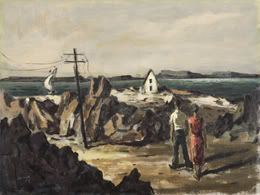
| | |
Hughie Lee-Smith, American; Two Figures and Landscape, 1954; oil on board. On loan from the Fitzgerald Public Schools.
| |
Sometimes works come to the DIA through circuitous means. Two Figures and Landscape by Hughie Lee-Smith, currently on view in the African American galleries, is a case in point. The 1954 painting by the renowned artist is on long-term loan from Warren's Fitzgerald Public Schools, where the work had been all but forgotten for years. It was a former student who, after seeing an article about Lee-Smith, alerted school officials that the painting hanging in the Fitzgerald High School break room might be a hidden treasure.
The painting dates from the early years of the artist's career, when he was in Detroit studying art at the Art School of the Detroit Society of Arts & Crafts, now College for Creative Studies (CCS) and Wayne State University. It differs from the images for which Hughie Lee-Smith is best known: works that include a lone figure in an urban environment, such as the DIA's The Piper and Boy with Tire on view in the same gallery. Lee-Smith is important, says curator and head of the General Motors Center for African American Art Valerie Mercer, as an early modernist "who depicts the urban environment, which is central to a lot of the African-American experience."
Two Figures and Landscape was a gift from the 1954 graduating class at Fitzgerald High School. Fitzgerald Public Schools Superintendent Barbara van Sweden said, after learning the identity of the painter, that "it made sense to loan our painting to the DIA so it could enhance the collection by this notable artist and be appreciated by visitors to the gallery." Those visitors included students from three Fitzgerald schools, who came to see "their painting" on field trips made possible by a grant from Target.
Back to top |
|
 Glass Month Glass Month
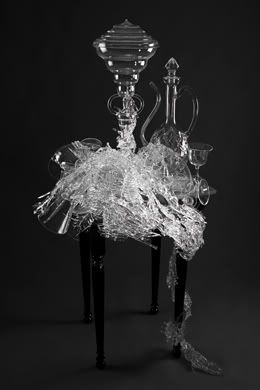
| | |
Beth Lipman, American; Still Life with Vines, 2011; blown glass, wood. Museum Purchase, Friends of Modern Art Acquisition Fund and Friends of Modern Art, Modern Decorative Arts Fund. Courtesy of the artist and Heller Gallery, New York
| |
April is national Glass Month, which this year celebrates the fiftieth anniversary of the American studio glass movement and, at the DIA, the opening of the renovated Aviva and Jack A. Robinson glass gallery. The gallery features new cases and upgraded lighting.
The American studio glass movement started in 1962 with the introduction of a small furnace built for working glass in artists' studios. Notable works in the DIA's collection include those by Harvey Littleton, Dominick Labino, Dale Chihuly, Howard Ben-Tré, Herb Babcock, and Therman Statom. Exhibited for the first time are recent acquisitions by Beth Lipman and Preston Singletary.
Lipman's Still Life with Vines, a tea table with forty-eight individual objects, pays homage to seventeenth-century still lifes by European masters who painstakingly rendered details like a fine crumb on a loaf of bread or the sparkling glint of fine crystal. Lipman recreates such images in clear glass, draining them of color and substance, which blurs the identities of each form. Translucence and multiple reflections mask the clarity of Lipman's well-crafted forms, dissolving the boundaries between them.
A noted Tlingit artist, Singletary based his Spirit Box on traditional bentwood boxes made from single planks of cedar decorated with clan crests or images of supernatural beings. These prized containers often held sacred or ceremonial objects and were exhibited by the elite at potlatches as demonstrations of social power and wealth.
Aviva and Jack A. Robinson endowed the gallery in 1996 and made the most significant donation of glass in the museum's history.
Rebecca Hart, DIA associate curator of contemporary art, gives a talk on the DIA's studio glass collection on Friday, April 27, at 7 p.m.
Back to top |
|
 Inside|Out Inside|Out
Awesome, very cool, WOW, brilliant, love it soo much are typical comments area residents made as the DIA's Inside|Out program placed high-quality reproductions of masterpieces in twelve communities for the next three months. The popular program, now in its third year, brings art to the streets and parks of metro Detroit.
Seven to ten images were recently installed in the Bloomfield area, Clarkston, Eastpointe, Farmington, Farmington Hills, the Grosse Pointes, Mt. Clemens, Roseville, Southfield, Taylor, Wayne, and Wyandotte. Where ever possible, the art works are clustered in close proximity and communities are scheduling walking or bike-riding tours, as well as other special events. George Bellows's A Day in June (top left), for example, resides in Farmington, where city officials have scheduled a reenactment of the painting, urging residents to wear white and not forget their green parasols. Appropriately enough, the event is planned for a day in June, June 8 to be precise.
One poster to the Inside|Out Facebook page reported taking the family to the Taylor Conservatory to visit Monet's Gladioli (bottom left). "Now, they want to participate with the DIA! They loved them!" That's just the sort of comment we love to hear, and to facilitate access to the museum and its collection, the DIA offers free museum admission to residents of participating communities on select Family Sundays. For more on the free days, check out the Inside|Out page on the DIA's Web site and click on a community's name. Maps with locations for all the reproductions are also available on the site.
Despite threats by residents to chain themselves to the art or offers from municipalities and businesses to buy the reproductions, the masterpieces are only on view in any community for three months. Come July, they'll be on the way to new temporary homes.
Inside|Out 2012 is sponsored by the John S. and James L. Knight Foundation
Back to top |
|
 Arts and Flowers Arts and Flowers
 | |
If April showers bring May flowers, then "Fruitful Blossoms," the Thirteenth Annual Elizabeth Sites Kuhlman lecture and floral demonstration on May 2 couldn't come at a better time. This year's speaker, Ron Morgan, began his career in floral design at age ten, when he won his first flower show competition in San Joaquin County, California. He has gone on to design window displays for noted establishments, open retail flower and antique shops, consult as an interior designer, and conduct flower-arranging classes. Join him for "Fruitful Blossoms" as he showcases his spontaneous floral designs, incorporating everything from the seed, to the flower, to the fruit. A luncheon and book signing follows the 10:30 a.m. lecture and demonstration. The annual Friends of Art and Flowers lecture is very popular, so early ticket purchase is highly recommended. Tickets are available online or through the DIA Box Office: 313.833.4005. For more information or reservations, contact Elisia Wheeler, 313.833.9830 or ewheeler@dia.org.
Sponsored by the Friends of Art & Flowers
Back to top |
|
|
|
|
|
Detroit Institute of Arts
5200 Woodward Avenue
Detroit, Michigan 48202
www.dia.org
313.833.7900
Comments or questions about the newsletter? Please contact us: comments@dia.org
ADMISSION
$8 adults, $6 seniors, $4 children
The museum is free for members
Contact the Membership HelpLine at
313.833.7971 or membership@dia.org
For group sales (15 or more) contact 313.833.1292 or dia.org/grouptours
CATERING & RENTALS
Call 313.833.1925 or
catering@dia.org
|
HOURS
Museum
Mon, Tue CLOSED
Wed, Thur 10 a.m.-4 p.m.
Fri 10 a.m.-10 p.m.
Sat, Sun 10 a.m.-5 p.m.
PARKING
Valet parking is available at the Farnsworth entrance on Fridays, Saturdays, and Sundays, during regular museum hours. The price per car is $8.
Lighted, secure self-parking is available in the Cultural Center parking lot, between John R and Brush, behind the museum.
Ford Free Second Sundays are generously supported by the Ford Motor Company Fund. Next Ford Free Sunday, April 8.
|
CaféDIA
313.833.7966
Wed, Thur 11:30 a.m.-2:30 p.m.
Fri 11:30 a.m.-2:30 p.m., 5-9 p.m.
Sat, Sun 11:30 a.m.-3 p.m.
Kresge Court Coffee Stop
Wed, Thur 10 a.m.-3 p.m.
Fri-Sun 10 a.m.-4 p.m.
Museum Shop
313.833.7944
Open during museum hours
|
|
|
|
|
|











